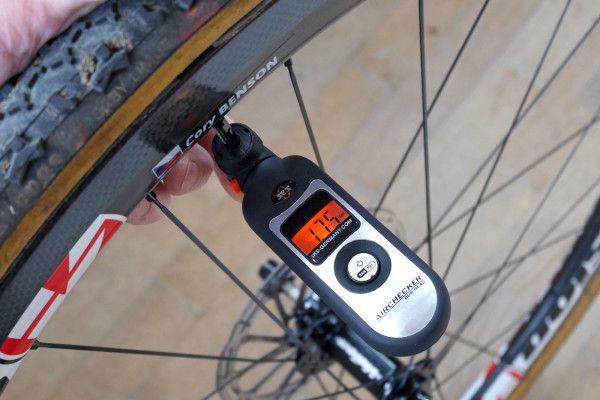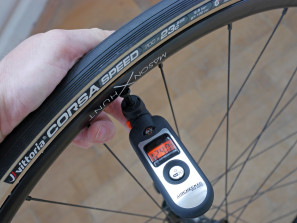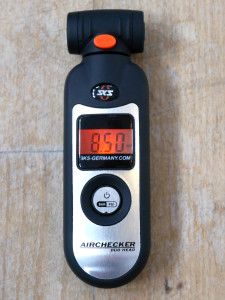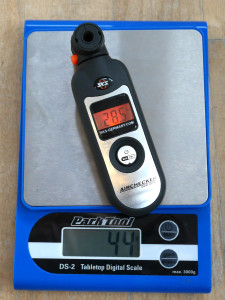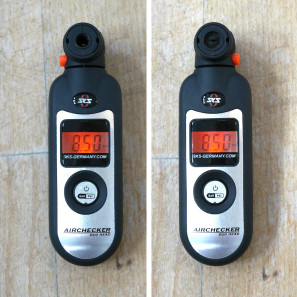With cyclocross season in full swing, the weather in Europe has been cycling back-and-forth, all over the place. One race weekend has been be warm and sunny, then the next was frosty and gray. That’s makes tire selection and tire pressure choices even more important as we try to squeeze out the last bit of grip from a wide range of tubulars and tubeless tires that we have on test. We already raced on everything from dry hardpack and grass, to slow and slick muds, to wet and frost covered grasses. To get tire testing right, we need accurate and repeatable tire pressure measurement, and for the last couple of seasons we have begun to rely on the Airchecker, a small handheld digital pressure gauge from SKS. Jump past the fold to get the details and our thoughts…
The Airchecker is a small, easy-to-use digital gauge that we are able to pop in our pockets while pre-riding a cross course or out experimenting with new tires. It certainly gets the most use in cyclocross season, where we dial in pressures to 1/2 of a psi or 5/100ths of a bar, but it also has served well in its upper ranges when we were looking at road tubulars or new road tubeless tires (like Vittoria’s ultra fast Corsa Speed.) We seldom get tires above 101psi/7bar, spending most of our time down in the 22-29psi/1.5-2bar range, but the Airchecker is rated up to 144psi/10bar.
Pretty much every gauge we have used has some significant performance compromise, whether the gauge is too heavy or bulky, hard to read, hard to line up with the valve, requires constant button pushing to get a measurement, or is just overly expensive. But so far the SKS Airchecker seems to be the one I’ve been most happy with. Its compromise is that you have to remove the head from the valve each time to make a new measurement. So even though that small orange button on the side of the head releases a little pressure with each press, we have to pull the head off the tire’s valve to check to see how much pressure was really bled off. OK, thanks to an early comment from Edubs, I’ve gotten ahold of the current version (vs. the older one I’ve had on test for quite a while) and can confirm that the pressure updates as the air is bled out. While the previous version required reseating the valve to get an updated pressure, the currently available Airchecker is live-updating, taking away the only real compromise this gauge had.
After using the gauge for the first couple of weeks, we had gotten the hang of it, and for more than a year have been comfortable reliably measuring the pressure, bleeding off air, and rechecking the pressure without losing unnecessary air. We’ve also gotten a feel for it with practice, so that now to drop 1psi, we give the orange button 3 quick taps, and are done. It seems that with the new live-updating pressure reading, our practiced skill of bleeding air has become obsolete, other than not losing air on the one time we now have to seat the gauge on the valve. With this feature update, we are even more comfortable recommending this gauge.
The all plastic Airchecker uses a single watch battery, has a backlit screen, and automatically shuts itself down. We’ve used it regularly for more than a year and have yet to need to change the battery. Its simple operation takes just one button to wake it up, then toggle between psi and bar units. Pressure display is automatic when you press it onto a valve, and it holds the measurement on the screen for several seconds even after it’s pulled from the valve, or until it is pressed onto the valve again. The gauge has a head that swivels 90º each way with a schrader valve on one side and a presta valve on the other. It would probably be nice if the head rotated a bit further in both directions, but we’ve gotten used to this as well. And its positioning works perfectly well when standing over a wheel with the valve at the 12 o’clock position, the most common/rational spot for it anyway. There is no outward difference that we could see between the old and new gauges, so we’ll just have to assume that any new stock will include the new live-updating pressure feature.
At just 44g, the $25/30€ Airchecker goes on at least the first test ride we do with every new tire or wheel combination, and spends the fall traveling to every cross race we do. Then when it’s the tire pressure off season, it gets rubber banded to a mainstay floor pump for less frequent use and to realize how much one pump’s gauge varies from the next. Of the half dozen or so gauges that we have tried so far, this is the one we recommend to friends looking for accurate, repeatable tire pressure monitoring for cyclocross.
